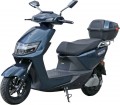Wheel size
tThe diameter of the wheels used in the vehicle. For models with wheels of different sizes, the largest diameter is usually indicated, other data can be specified in the notes.
For electric scooterbikes, the traditional size is a modest 10"; larger sizes are also found — up to
16". Among minibikes, large
18" wheels are more common. Electric motorcycles have small wheels — an average of 12 – 14". Among electric tricycles, a combination of a large front wheel with small rear wheels is often found — for example, 16 "and 4" each, respectively.
The large diameter allows you to roll over the bumps on the road, overcome rather large obstacles and maintain speed longer when coasting; on the other hand, such wheels require more torque from the engine, they accelerate worse and reduce the maximum speed of the unit. Small wheels, on the contrary, accelerate well and also provide good manoeuvrability, but they are intended mainly for flat roads.
Power
The motor power of a vehicle, in horsepower.
In general, the power of electric motors is indicated in watts. However, in electric transport, this designation is also often indicated. This is done for the convenience of comparison with internal combustion engines: for internal combustion engines, especially in vehicles, horsepower is traditionally used, and it is more convenient for some users to evaluate the power of motors by this designation. At the same time, if the need arises, some units are easily converted to others: 1 hp. ≈ 735 W.
For the power value in general, see the relevant paragraph below.
Power
The motor power of a vehicle, in kilowatts. In addition to them, horsepower is also used (for more details, see above).
Let us clarify that in this case, we are talking about
maximum power; the actual power can be adjusted while driving with the help of the accelerator. And in some models, it may even be possible to set a limit on the maximum power.
A more powerful motor allows you to carry more weight, reach higher speeds and/or have more torque. However, the energy consumption from the battery will also be high, and the battery life, with the same battery capacity, will be correspondingly less than when using a less powerful motor. Also note that in many countries, motor power is a criterion for classifying an electric vehicle as one or another variety. For example, according to this criterion, motorcycles and scooters can be formally separated, requiring different driving licences.
Battery type
—
Lead-acid. The most popular type today. Their design is based on a combination of electrodes made of lead compounds and an electrolyte, the role of which is played by sulfuric acid diluted with water. It is the classic type of batteries that use a conventional liquid electrolyte. Their widespread use is due to their simple design and low cost, combined with good capacity and starting currents characteristic of all lead-acid batteries, as well as resistance to low temperatures (compared to other types of batteries).
—
Lithium-ion (Li-Ion). Lithium-ion technology was originally used in batteries for portable gadgets such as mobile phones, but such batteries are being used more and more recently in vehicles. Among the advantages of such batteries, one can note smaller dimensions and weight, the ability to deliver high starting currents and the ability to be charged with high currents (the latter significantly reduces the charging time), as well as numerous charge-discharge cycles. In addition, such batteries contain a minimum of harmful substances, do not use acids and heavy metals, and some models are even directly positioned as absolutely harmless to the environment. The main disadvantage of lithium-ion models is the high price.
—
Gel. A type of lead-acid battery in which the electrolyte is not liquid, but condensed to a gel state. This design prov
...ides several advantages compared to the classic version (see above): more charge-discharge cycles (which means longer service life); minimum leakage of electrolyte and associated gases; no need for maintenance; resistance to deep discharges and temperature fluctuations, etc. On the other hand, such batteries cost significantly more.Removable battery
The presence of
a removable battery allows you to replace it with a more capacious one. This option also allows you to change one for another on the road, thereby increasing the range.
Weight
The total weight of the vehicle without cargo and rider.
The
lighter the unit, the greater the range and, accordingly, the weight of the payload that can be carried on it. On the other hand, too little weight adversely affects the stability, and sometimes the overall strength of the structure.

